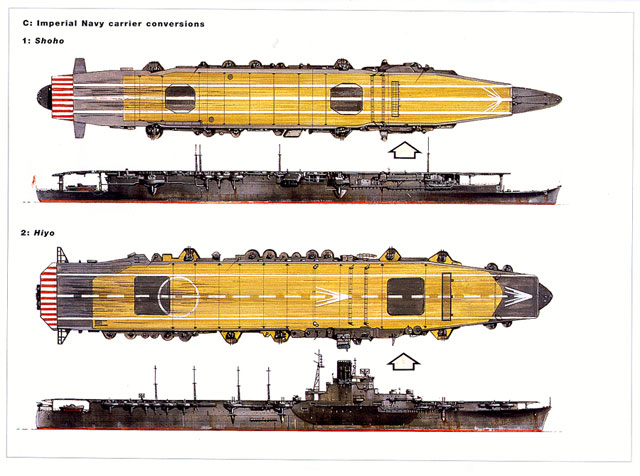Reviewed by Rodger Kelly

Osprey's
"Imperial Japanese Navy Aircraft Carriers"
will be available online from Squadron.com
Imperial Japanese Navy Aircraft Carriers 1921 – 1945 is
the latest release from Osprey publishing and
is number 109 in their Vanguard Series.
The Imperial
Japanese Navy (IJN) were amongst the pioneers of carrier aviation prior to World
War Two and this book, as well as chronicling their carriers, advises on the
differences in the IJN operational procedures from the Royal Navy and the US
Navy.
Some
examples of these include the fact that all IJN aircraft maintenance was carried
out below decks and that all of their aircraft were stored on the hangar deck.
Why is this significant? Well, it explains why their carriers actually carried
so few aircraft for their size.
The book
also fully explains the deck marking system used by the IJN. Why did the flight
deck carry red and white markings towards the stern? Well, it was used by their
pilots as an approach aid during the landing-on phase of operations. It also
advises on the fact that the IJN used a series of fixed lights to assist their
pilots in landing during World War Two. It is information like this that make
this book so interesting.
The book
consists of ten chapters in all as well as a bibliography, a commentary for the
colour plates that it also contains, and an index.
The chapters
are:
-
Introduction.
-
Japanese Carrier
Development.
-
Aircraft, Aircraft
Operations, and Aircraft Handling Facilities.
-
Carrier Shipboard Weapons.
-
Carrier Radar and Fighter
Defence
-
Carrier Names
-
Pre-War Built Carriers
-
The Light Carrier
Conversions
-
Fleet Carrier Wartime
Construction
-
The Escort Carriers
-
Conclusion
The Pre-War
Built Carriers, The Light Carrier Conversions, Fleet Carrier Wartime
Construction, and Escort Carriers chapters list each of the appropriate carriers
by class and individual name. These descriptions include the 'how long and how
heavy' statistics as well as an operational history of each ship and what their
name meant – for example, HMIJS Shoho was Happy Phoenix and
HMIJS Zuiho was Lucky Phoenix.
In line with
the rest of the book, the colour illustrations are also very informative and the
cations to them fully explain each and all of the deck markings worn. We have
all probably seen the footage of the strike force aircraft leaving their
carriers to attack Pearl Harbour. Ever wonder why there is steam escaping from
the forward edge of the flight deck? Did you assume that it was from a steam
catapult? Well you are wrong. S this book advises, IJN carriers were not
equipped with catapults at all. The steam was a means of telling the pilot the
wind direction. The pilots lined the escaping steam up with the white painted
lines on the flight deck and hey presto, they had the degree of wind over the
bows at launch and made the appropriate adjustments to trim.
The book is
illustrated with 45 black and white photographs and by seven pages of colour
paintings by
Tony Bryan.

The book
itself consists of 48 pages printed on glossy paper between thin cardboard
covers and is the same size as the Aircraft of the Aces and Combat Aircraft
series produced by Osprey.
With an
interest of all things World War Two Japanese, I found this to be an excellent
tome. It is logically laid out and very informative.
Recommended
for the armchair admiral and to anyone else who has an interest in the IJN in
World War Two.
Recommended
Thanks to
Osprey Publishing for the review
copy
Imperial Japanese Navy
Aircraft Carriers 1921-1945
(New Vanguard 109) |
|
|
|
|
Author: Mark Stille
Illustrator: Tony Bryan
US Price: $14.95
UK Price: £8.99
Publisher:
Osprey Publishing
Publish Date: May 10, 2005
Details: 48 pages; ISBN: 1841768537 |
|
|
Review Copyright © 2005 by
Rodger Kelly
Page Created 12 May, 2005
Last updated 11 May, 2005
Back to HyperScale
Main Page
Back to Reviews
Page
Home | What's
New | Features
| Gallery |
Reviews | Reference
| Forum
| Search